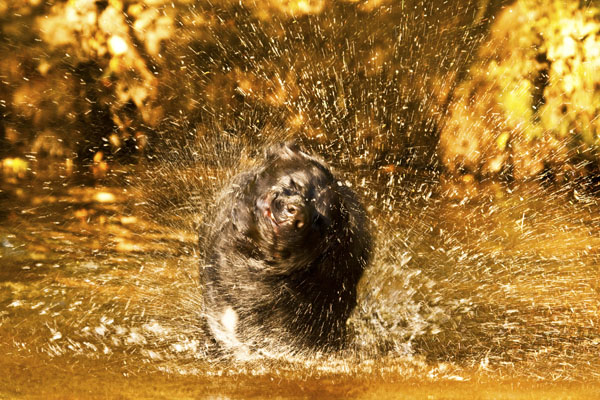PREPARING YOUR HOME FOR A NEW DOG/PUPPY
Preparing your home for the imminent arrival of a new pup or adult dog needs some serious thought and consideration. The things you do now and how you collect and bring your new friend home can have lasting effects on some of your pets behaviour so care should be taken. The requirements of a puppy and an adult dog do vary slightly so I will address each individually.

THE PUPPY.
Puppy proofing your home:-
The first thing I would like to say is when thinking about how to puppy proof your house you would be good to think along the same lines as preparing for a new highly mobile baby in the house, for that is what it is like, though your puppy will not only be highly mobile from day one, they will also have a decent set of needle teeth to open things up with. Much of the following is obvious but we will have a look anyway.
Firstly we want to ensure that there is nothing in the environment that might injure or worse for your pup. Remove any obvious sharp or dangerous objects that a mad pup might run into when tearing around (which they will) inside and outside. Remove sweets and human chocolate from their reach (can be toxic to dogs). Ensure there are no garden chemicals like slug pellets, ant killer etc that are unsafe/toxic or worse for dogs. Make sure you have no cocoa shells as part of you garden landscaping as they are very appetising to dogs and are toxic and sometimes lethal to them (there have been cases of dog deaths attributed to this).
Keep your lower indoor surfaces clear of food items or anything of appeal to a pup or that funny “scrambling on the coffee table” to get something nice, that you laugh at, might turn into a real problem when they grow bigger. Electric cables need to be out of reach for electrocution is a real threat if puppy has access. Be extra aware when leaving your pup on his own for the first few times for they might well seek out hiding places like behind the TV when worried and chew through things out of anxiety, or even boredom and frustration if they manifest (see the /separation-anxiety-in-dogs section).
Like children keep your human medications out of reach and remember they can chew through things to get at the contents. Plastic bags left around that have previously contained something very interesting (food) to your pup might well be eaten, resulting in an expensive trip to the vets. Make sure your garden is well fenced in and remember an adult dog can clear a five foot fence easily if it wants to, for puppies low down is important too (no small gaps for them to crawl through), it doesn’t have to be fort Knox but needs to be safe for all concerned. Many dogs that do manage to escape from the garden will turn into escape artists if you don’t rectify things (especially Huskies/Malamutes). If your dog does escape from your property and you know how they done it get it fixed ASP or they will almost certainly return to that place and do it again, they can't help it, bless them.
If you have a garden pond then ensure it is safe for your pup to be around as puppies have drowned in such if not properly contained or when the pup is not supervised, you should supervise them until you are reasonably sure of their ways. Some garden plants are toxic to dogs and some can be lethal, the list here is extensive, so I will list the more common ones, other more extensive lists are easily found on the web. The more common ones are Rhododendron, Yews, Daffodil (bulbs), azalea, Laburnum, Foxgloves, Rhubarb, Cherry laurel, Lily of the valley, Lilies(bouquets). Also grapes and raisins can be toxic to many dogs.
Anti freeze is particularly attractive to dogs (smell) and if drunk even in small amounts can be lethal. Toys that you get for your new friend must be puppy friendly, really they should be supervised when young and if you leave them with something while you are not there these must be safe, i.e. indestructible. A good thing is a puppy Kong filled with something nice that will not choke puppy, these are great for leaving when you first start to leave them as they provide interest in those vital first few minutes, studies have shown that separation issues come on in the first few mins of leaving them so if something nice is left to occupy them in those first few mins it helps them, (more about thisr in the /separation-anxiety-in-dogs topic).
Two weeks before you go to collect your pup plug a DAP (Dog appeasing pheromone, brand name Adaptil) diffuser in one of your home plug sockets, plug it in and leave it in, preferably in the room that your pup will spend most time in and ideally if budget allows have one on each level of your home. This looks like and works like an air freshener but puts a chemical copy of the pheromone that a bitch produces to calm her anxious pups into the air. Your pup will recognize this and it will help provide a calming atmosphere. The association that pups have with this pheromone is carried on into adulthood so it is also a good tool to help older dogs too, more about this later.
These DAP's are not a lot of money and they often help a lot, they must be left plugged in and a refill lasts about four weeks. Try them for the first 8 weeks (one unit which comes full and one refill). I would like to add here that if you do not get your pup from a good home with the mother in attendance, (puppy farm, bad home) then a DAP will probably not work as they didn't experience these pheromones for real with mother before you took them to your home, obvious really.All of the above can be looked at well before getting your new little friend home. Now lets have a look at preparing your home for an adult dog. Many times a new owner may not truly know for certain the history of an adult dog to date and the learning and environment that that dog has experienced. Many behaviours associated with puppy behaviour may still be present and in some cases more intense, hopefully reading the picking the right adult dog has helped guide you through this. Some problem behaviours may not become apparent till after a settling in period when the dog becomes bolder. These things need addressing as they arise but to start before your dog arrives we can look at the following.
Adult dog proofing your home :-
The first thing to look at would be making your property escape proof, unless you are totally familiar with the dog and its behaviour a six foot fence for the garden is the best bet, with no holes anywhere to allow escape, sounds like alcatraz I know but if you don't know the dog well you can't be sure. A lot of dogs could get over a six foot fence but most unless already true escape artists (a naughty husky for instance) will not try, anyway if you have read the which adult dog and breed sections as a new owner you hopefully wouldn't be getting a husky; if you know the breed and what you are doing then carry on. Ponds are not a problem in relation to drowning for most adult dogs but could possibly be if your dog is a very small breed and the pond well overgrown so common sense dictates if you need to contain it or not, (or get your gloves on and clear out the pond). Also terrorizing your prize Koi or goldfish may be an issue. For the first few days you should supervise your new best friend in the garden.
Your new best friend may indeed be a grass or vegetation eater if his previous learning for whatever reason has made him so, if your garden has lots of flora it would be advisable to check your garden for the toxic species as above in the puppy section and others found in lists on the web. I would say that you should apply all of the above for the puppy to the adult dog too in relation to, anti freeze, human medications, non dog food, garden chemicals/cocoa mulch, bags, grapes, raisins, cables, toys and any obviously sharp or dangerous objects that an excited dog may run into.
The DAP would be well employed for adult dogs too as the association with it as I said earlier is carried on into adulthood, again plug it in two weeks before getting your new friend and leave it plugged in as above, one on each floor if budget permits. Doubtless there are many dogs out there that started of life with their new owners without a DAP adapter in place as they are a relatively new addition to the dog behaviourists tool bag, but I think that if you are looking at up to twenty years with a new family member and best friend then any possible help that might make this an easier more pleasurable experience is worth taking, they are not a lot of money. Again it doesn't work with all dogs, mostly for the above reason; as a puppy they were not brought up for the first eight weeks with mum.
With your new friend start as you mean to go on in relation to allowing on furniture, bed, where they sleep etc, stick to your guns with firm fair behaviour. My dog gets on the furniture, bed and sleeps in my room but I have no issues with him. If your new friend has or develops issues over bonding, being the boss or similar then not allowing the previous would be advisable, consistency is paramount here and you have to get all the family on the same page, even visitors too (see the /be-in-control-of-your-dog topic for more). I know this sounds a bit over the top but the initial work you put in will be well rewarded later in you and your dogs life.
You may well have other pets in your house like other dogs, cats, rabbits etc. Hopefully you have read the picking the right adult dog section and you don't have a problem dog coming to your home. If you have a dog or dogs already in residence then meetings with the future planned new dog in a safe neutral environment before bringing them home would be beneficial. If you are planning to take on a dog from a rescue centre you should be able to arrange a meeting of your present and future dogs at the centre to see how they get on, hopefully in an outside large safe area and in a controlled gradual way. Hopefully you could also sort out something similar if getting your dog from a private owner or breeder.
Find out more info on my /collecting-a-new-puppy-dog topic.
Why not take a look at my first book - Elmer no ordinary wolf, a realistic novel about a wolf called Elmer, his family and their life. My hope is that you would learn much about wolves and mother nature, coming I hope to understand why man first thought to domesticate these amazing social mammals to give us our best friend, the dog.
copyright 2013-22 Paul lindley
Topics
